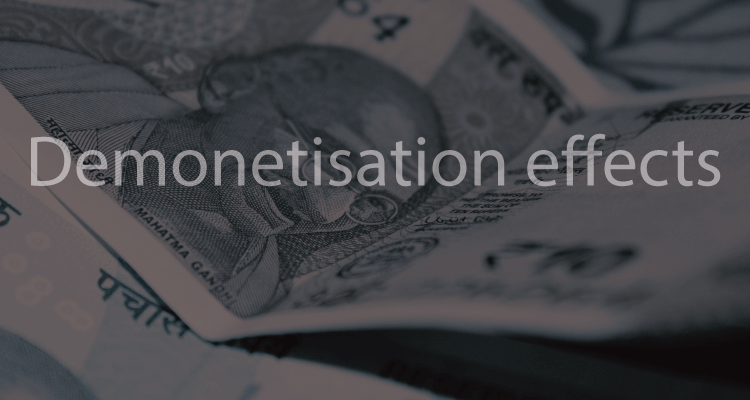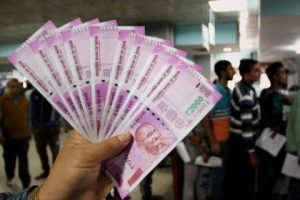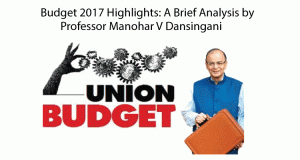On 8th November,2016,Prime Minister Narendra Modi came out with his master stroke on corruption, counterfeit currency, terrorism and black money by announcing demonetisation and ceasing Rs. 500 and Rs. 1000 notes as a part of legal tender in India. The Reserve Bank of India manages currency in India and derives its role in currency management on the basis of the Reserve Bank of India Act, 1934. A new redesigned series of Rs 500 banknote, in addition to a new denomination of Rs 2000 banknote is in circulation since November 10, 2016. The new redesigned series is also expected to be introduced to the banknote denominations of Rs 1000, Rs 100 and Rs 50 in the coming months.
While the pros and cons of the measure still continue to be debated, the consensus of opinion appears to be that while the proponents of demonetization may have had good intentions, the suffering it has caused to millions of Indians is unwarranted. Since Rs500 and Rs1000 notes make up some 86% of the total currency in circulation in India, especially in the vast rural areas, one economist compared the pain to what individuals might experience if 86% of their blood was removed from their bodies.
The net result can be a fall of between 0.5% and 2% in GDP,” says online news channel Firstpost. “The debate still goes on.”The goals which were earlier said to be of removing black money and fighting terrorism has now shifted to promoting cashless transactions. Several measures have been introduced, among them a 0.75% discount on digital payments made for buying petrol and diesel and a 0.5% cut in the price of railway season tickets bought using digital technology.
In another twist, the government appears to be no longer pushing demonetization as a “cashless” plan. It has now become a “less-cash” strategy. That is as it should be; the world doesn’t have a cashless economy so far. In India, Bloomberg data shows the share of cash in the volume of consumer transactions is 98% (against 55% in the U.S. and 48% in the U.K.). It is 90% in China and 86% in Japan. Much of the cash transactions are in rural India. So, expectedly, life came to a near standstill and much misery ensued when people found themselves unable to use their own money. Even when the money was in a bank account, limits on ATM withdrawals compounded the problem further.
Nobody is denying a short-term setback. The Reserve Bank of India (RBI) has reduced the GDP growth rate forecast for 2016-17 from 7.6% to 7.1%, the Asian Development Bank from 7.4% to 7%, Fitch from 7.4% to 6.9% and Bank of America-Merrill Lynch from 7.7% to 7.4% (for calendar 2016). All believe, however, that growth will recover the next year.According to the Economic Survey 2017, The faster the remonetisation takes place, the shorter and less severe will be the impact of demonetization”. The survey also notes that growth rate of industrial sector will moderate to 5.2 percent this fiscal, from 7.4 percent last fiscal year.
The survey also warns that note ban will adversely impact cash-intensive sectors such as agriculture, real estate and jewellery. On the digitization, Public policy must balance benefits and costs of both forms of payments. Second, the transition to digitalization must be gradual, take full account of the digitally deprived, respect rather than dictate choice and be inclusive rather than controlled,” said the survey.
Nearly three months into demonetisation, the cash crunch still continues. On Monday, the RBI announced some relaxations on cash withdrawals but it has not yet given a final word on till when the cash curbs will be withdrawn fully.
By now, it is a fact that the cash crunch has already hit the informal sector badly. Hit the consumption demand in the economy and resulted in job loss. According to a study by All India Manufacturers’ Organisation (AIMO), in the first 34 days since demonetisation, micro-small scale industries suffered 35 percent jobs losses and a 50 percent dip in revenue. The study showed nearly all industrial activities came to a standstill post note ban, with the Small and Medium-sized Enterprises (SMEs).
Simultaneously, Business confidence in India has slipped to a one-year low due to the demonetization drive introduced by Prime Minister Narendra Modi in November, according to a survey conducted by the Federation of Indian Chambers of Commerce and Industry (FICCI).
The survey, conducted between December 2016 and January 2017, showed the country’s Overall Business Confidence Index (OBCI) slipped to 58.2, compared to a figure of 67.3 for the same period last year. The survey drew responses from 207 companies and aimed to capture the assessment of the current situation, as well as gauge expectations regarding performance for the first half of this year.
“The sharp dip in current condition index can be attributed to the sudden spur of uncertainty created by the government’s move to demonetize high value currency notes,” the survey said. “Cash dependent sectors especially in the informal economy have been affected.
The economic growth projections and caution on the impact of demonetisation is reminder to the government that why it is crucial to resolve the cash crunch fast. Secondly, the survey cautions on the need for reforms on taxation and financial sector reforms. It moots faster reduction in corporate taxes.
Summary
The impacts which have been on the economy can be summarized as follows:-
- Stock of black money fell as some holders came in the tax net. The government expects formalization to reduce the flow of unaccounted income.
- Digital transactions among new users increased sharply; existing users’ transactions increased in line with historical trend.The government expects some return to cash as supply normalizes but the digital revolution to continue.
- Income taxes rose because of increased disclosures. Payments to local bodies and discoms increased because demonetized notes remained legal tender for tax payments, clearance of arrears.The government expects indirect and corporate taxes to decline, to the extent growth slows. Over the long run, taxes should increase as formalization expands and compliance improves.
- Decline in prices as wealth fell while cash shortages impeded transactions.The government expects prices to fall further as investing undeclared income becomes more difficult. Tax component is also expected to rise if GST is imposed on realty.
- Growth slowed as demonetization reduced demand, supply and increased uncertainty. The government says this could be beneficial in the long run if formalization increases and corruption falls.
- Uncertainty increased as firms and households were unsure of the economic impact and implications for demonetization. The government expects credibility to be strengthened if demonetization is accompanied by complementary measures. Early and full remonetization is essential.
- On top of all this, early estimates indicate that the Indian banks ended up receiving 97 percent of the banned bank notes by the December 30 deadline last year — far more than the government estimated would be returned, based on the assumption that illicitly held money would’ve simply been left undeclared.In other words, it appears that one key goal of Modi’s — to deal a financial blow to people using the cash for illegal purposes — simply didn’t bear fruit.
To be sure, even with the reduced growth projections, India is set to remain one of the fastest growing major economies in the world, growing at more than twice the global growth rate. Some institutions are betting on India to pass key reforms and follow-up actions to them that would ease the way for longer term benefits as demonetization impact ebbs.
Guess we’ll just have to keep watching.




